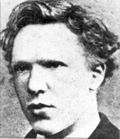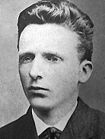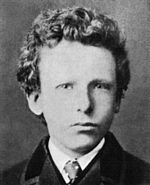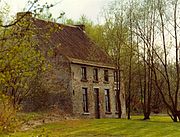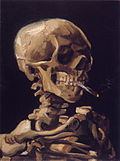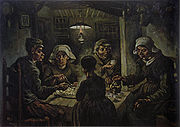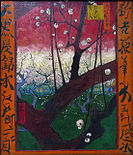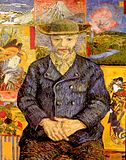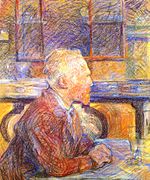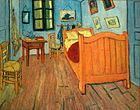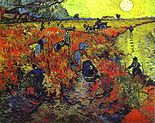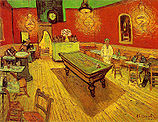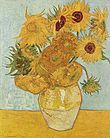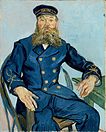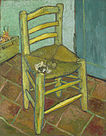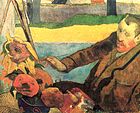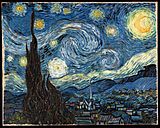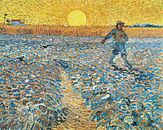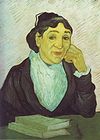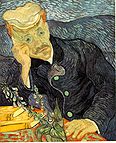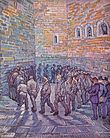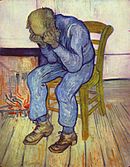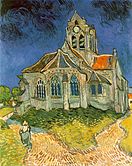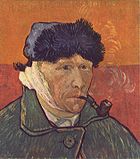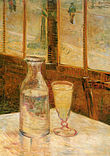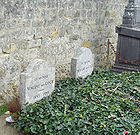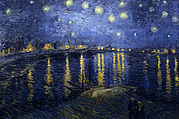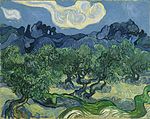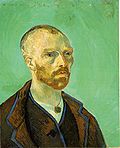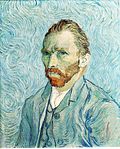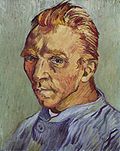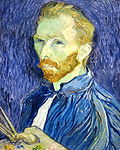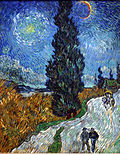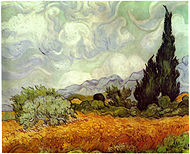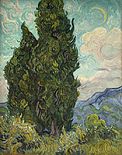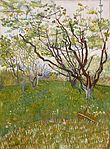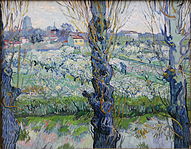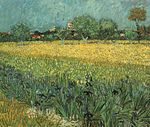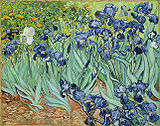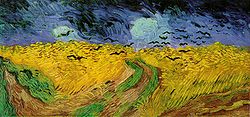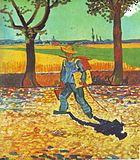
Vincent van Gogh
About this schools Wikipedia selection
SOS Children produced this website for schools as well as this video website about Africa. SOS Children works in 45 African countries; can you help a child in Africa?
| Vincent van Gogh | |
|---|---|
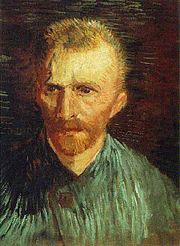 Self-portrait, summer 1887, Paris. Van Gogh Museum, Amsterdam |
|
| Birth name | Vincent Willem van Gogh |
| Born | Zundert, Netherlands |
| Nationality | Dutch |
| Field | Painter |
| Movement | Post-Impressionism |
| Works | The Potato Eaters, Sunflowers, The Starry Night, Irises, Portrait of Dr. Gachet, At Eternity's Gate |
| Influenced by | Anton Mauve, Jean-François Millet, Adolphe Joseph Thomas Monticelli, Impressionism |
Vincent Willem van Gogh (Dutch: [faŋˈxɔx], English: /ˌvæn ˈɡɒx/; 30 March 1853 – 29 July 1890) was a Dutch post-Impressionist painter whose work had a far-reaching influence on 20th century art for its vivid colors and emotional impact. He suffered from anxiety and increasingly frequent bouts of mental illness throughout his life and died, largely unknown, at the age of 37 from a self-inflicted gunshot wound.
Little appreciated during his lifetime, his fame grew in the years after his death. Today, he is widely regarded as one of history's greatest painters and an important contributor to the foundations of modern art. Van Gogh did not begin painting until his late twenties, and most of his best-known works were produced during his final two years. He produced more than 2,000 artworks, consisting of around 900 paintings and 1,100 drawings and sketches. Today many of his pieces—including his numerous self portraits, landscapes, portraits and sunflowers—are among the world's most recognizable and expensive works of art.
Van Gogh spent his early adulthood working for a firm of art dealers and traveled between The Hague, London and Paris, after which he taught in England. An early vocational aspiration was to become a pastor and preach the gospel, and from 1879 he worked as a missionary in a mining region in Belgium. During this time he began to sketch people from the local community, and in 1885 painted his first major work The Potato Eaters. His palette at the time consisted mainly of somber earth tones and showed no sign of the vivid coloration that distinguished his later work. In March 1886, he moved to Paris and discovered the French Impressionists. Later he moved to the south of France and was taken by the strong sunlight he found there. His work grew brighter in colour and he developed the unique and highly recognizable style which became fully realized during his stay in Arles in 1888.
The extent to which his mental illness affected his painting has been a subject of speculation since his death. Despite a widespread tendency to romanticise his ill health, modern critics see an artist deeply frustrated by the inactivity and incoherence brought about by his bouts of sickness. According to art critic Robert Hughes, Van Gogh's late works show an artist at the height of his ability, completely in control and "longing for concision and grace".
Letters
The most comprehensive primary source for the understanding of Van Gogh as an artist is the collection of letters which were passed between him and his younger brother, the art dealer Theo van Gogh. They lay the foundation for most of what is known about the thoughts and beliefs of the artist. Theo continually provided his brother with both financial and emotional support.
Their lifelong friendship, and most of what is known of Van Gogh's thoughts and theories of art, is recorded in the hundreds of letters they exchanged from August 1872 until 1890. Most were written by Vincent to Theo beginning in the summer of 1872. More than 600 letters from Vincent to Theo and 40 from Theo to Vincent survive today and although many are undated, art historians have been able to largely arrange the correspondences chronologically. Problems remain—mainly from dating those from the Arles period. Yet during that period alone, it is known that Van Gogh wrote 200 letters to friends in Dutch, French and English. The period when Vincent lived in Paris is the most difficult for art historians to examine because he and Theo shared accommodation and thus had no need to correspond, leaving little or no historical record of the time.
In addition to letters to and from Theo, other surviving documents include those to Van Rappard, Émile Bernard, Van Gogh's sister Wil and her friend Line Kruysse. The letters were first annotated in 1913 by Theo's widow Johanna van Gogh-Bonger. In her preface, she stated that she published with 'trepidation' because she did not want the drama in the artist's life to overshadow his work. Van Gogh himself was an avid reader of other artists' biographies and expected their lives to be in keeping with the character of their art.
Biography
Early life
Vincent Willem van Gogh was born on 30 March 1853 in Groot-Zundert, a village close to Breda in the province of North Brabant in the southern Netherlands. He was the son of Anna Cornelia Carbentus and Theodorus van Gogh, a minister of the Dutch Reformed Church. Vincent was given the same name as his grandfather—and a first brother stillborn exactly one year before. The practice of reusing a name in this way was not uncommon. Vincent was a common name in the Van Gogh family; his grandfather, Vincent, (1789–1874) had received his degree of theology at the University of Leiden in 1811. Grandfather Vincent had six sons, three of whom became art dealers, including another Vincent who was referred to in Van Gogh's letters as "Uncle Cent." Grandfather Vincent had perhaps been named in turn after his own father's uncle, the successful sculptor Vincent van Gogh (1729–1802). Art and religion were the two occupations to which the Van Gogh family gravitated. His brother Theodorus (Theo) was born on 1 May 1857. He had another brother, Cor, and three sisters: Elisabeth, Anna and Willemina (Wil).
As a child, Vincent was serious, silent and thoughtful. He attended the Zundert village school from 1860, where the single Catholic teacher taught around 200 pupils. From 1861, he and his sister Anna were taught at home by a governess, until 1 October 1864, when he went away to the elementary boarding school of Jan Provily in Zevenbergen, the Netherlands, about 20 miles (32 km) away. He was distressed to leave his family home, and recalled this even in adulthood. On 15 September 1866, he went to the new middle school, Willem II College in Tilburg, the Netherlands. Constantijn C. Huysmans, a successful artist in Paris, taught Van Gogh to draw at the school and advocated a systematic approach to the subject. In March 1868, Van Gogh abruptly left school and returned home. A later comment on his early years was, "My youth was gloomy and cold and sterile". In July 1869, his uncle helped him obtain a position with the art dealer Goupil & Cie in The Hague. After his training, in June 1873, Goupil transferred him to London, where he lodged at 87 Hackford Road, Brixton, and worked at Messrs. Goupil & Co., 17 Southampton Street. This was a happy time for him; he was successful at work and was, at 20, earning more than his father. Theo's wife later remarked that this was the happiest year of Van Gogh's life. He fell in love with his landlady's daughter, Eugénie Loyer, but when he finally confessed his feeling to her, she rejected him, saying that she was already secretly engaged to a former lodger. He was increasingly isolated and fervent about religion. His father and uncle sent him to Paris to work in a dealership. However, he became resentful at how art was treated as a commodity, a fact apparent to customers. On 1 April 1876, his employment was terminated.
Van Gogh returned to England for unpaid work. He took a position as a supply teacher in a small boarding school overlooking the harbour in Ramsgate, where he made sketches of the view. When the proprietor of the school relocated to Isleworth, Middlesex, Van Gogh moved to the new location taking the train to Richmond and the remainder of the journey by foot. However the arrangement did not work out and he left to became a Methodist minister's assistant, to follow his wish to "preach the gospel everywhere." At Christmas, he returned home and worked in a bookshop in Dordrecht for six months. However, he was not happy in this new position and spent most of his time in the back of the shop either doodling or translating passages from the Bible into English, French and German. His roommate at the time, a young teacher called Görlitz, later recalled that Van Gogh ate frugally, and preferred not to eat meat.
Van Gogh's religious emotion grew until he felt he had found his true vocation. In an effort to support his effort to become a pastor, in May 1877, his family sent him to Amsterdam to study theology. He stayed with his uncle Jan van Gogh, a naval Vice Admiral. Vincent prepared for the entrance exam with his uncle Johannes Stricker; a respected theologian who published the first "Life of Jesus" available in the Netherlands. He failed, and left his uncle Jan's house in July 1878. He then undertook, but failed, a three-month course at the Vlaamsche Opleidingsschool Protestant missionary school in Laeken, near Brussels.
In January 1879, he took a temporary post as a missionary in the village of Petit Wasmes in the coal-mining district of Borinage in Belgium. Taking Christianity to what he saw as its logical conclusion, Van Gogh opted to live like those he preached to—sharing their hardships to the extent of sleeping on straw in a small hut at the back of the baker's house where he was billeted. The baker's wife reported hearing Van Gogh sobbing all night in the hut. His choice of squalid living conditions did not endear him to the appalled church authorities, who dismissed him for "undermining the dignity of the priesthood." He then walked to Brussels, returned briefly to the village of Cuesmes in the Borinage but gave in to pressure from his parents to return home to Etten. He stayed there until around March the following year, a cause of increasing concern and frustration for his parents. There was particular conflict between Vincent and his father; Theodorus made inquiries about having his son committed to the lunatic asylum at Geel.
He returned to Cuesmes where he lodged with a miner named Charles Decrucq until October. He became increasingly interested in the people and scenes around him. He recorded his time there in his drawings, and that year followed the suggestion of Theo and took up art in earnest. He traveled to Brussels that autumn; intending to follow Theo's recommendation to study with the prominent Dutch artist Willem Roelofs, who persuaded Van Gogh, in spite of his aversion to formal schools of art, to attend the Académie Royale des Beaux-Arts in Brussels. He registered on November 15, 1880. While in attendance, he not only studied anatomy but also the standard rules of modeling and perspective, of which he said, "...you have to know just to be able to draw the least thing." Van Gogh wished to become an artist while in God's service as he stated, "...to try to understand the real significance of what the great artists, the serious masters, tell us in their masterpieces, that leads to God; one man wrote or told it in a book; another in a picture."
Etten, Drenthe and The Hague
In April 1881, Van Gogh moved to the Etten countryside with his parents where he continued drawing, often using neighbors as subjects. Through the summer he spent much time walking and talking with his recently widowed cousin, Kee Vos-Stricker. She was the daughter of his mother's older sister and Johannes Stricker, who had shown warmth towards the artist. Kee was seven years older than Van Gogh and had an eight-year-old son. He proposed marriage, but she refused with the words, "No, never, never" (niet, nooit, nimmer). Late that November, he wrote a strongly worded letter to his uncle Stricker, and then hurried to Amsterdam where he again spoke with Stricker on several occasions. Kee refused to see him and her parents wrote, "Your persistence is disgusting". In desperation, he held his left hand in the flame of a lamp, with the words "Let me see her for as long as I can keep my hand in the flame." He did not clearly recall what next happened, but later assumed that his uncle blew out the flame. Kee's father made it clear that there was no question of marriage given Van Gogh's inability to support himself financially. Van Gogh's perception of his uncle and former tutor's hypocrisy affected him deeply. That Christmas he quarreled violently with his father, to the point of refusing a gift of money, and left for The Hague.
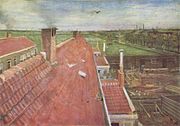
In January 1882, he settled in The Hague where he called on his cousin-in-law, the painter Anton Mauve (1838–1888). Mauve introduced him to painting in both oil and watercolour and lent him money to set up a studio; however the two soon fell out, possibly over the issue of drawing from plaster casts. Mauve appears to have suddenly gone cold towards Van Gogh and did not return a number of his letters. Van Gogh supposed that Mauve had learned of his new domestic arrangement with an alcoholic prostitute, Clasina Maria "Sien" Hoornik (1850–unknown) and her young daughter. He had met Sien towards the end of January, when she had a five-year-old daughter and was pregnant. She had already borne two children who had died, although Van Gogh was unaware of this. On 2 July, Sien gave birth to a baby boy, Willem. When Van Gogh's father discovered the details of their relationship, he put considerable pressure on his son to abandon Sien and her children. Vincent was at first defiant in the face of opposition.
Van Gogh's art dealer uncle, Cornelis, commissioned 20 ink drawings of the city, which the artist completed by the end of May. That June, he spent three weeks in a hospital suffering from gonorrhea. That summer he began to paint in oil. In autumn 1883, after a year together, he left Sien and the two children. Van Gogh had thought of moving the family from the city, but in the end made the break. It is possible that lack of money had pushed Sien back to prostitution—the home had become a less happy one, and likely Van Gogh felt family life was irreconcilable with his artistic development. When he left, Sien gave her daughter to her mother and baby Willem to her brother. She then moved to Delft, and later to Antwerp. Willem remembered being taken to visit his mother in Rotterdam at around the age of 12, where his uncle tried to persuade Sien to marry in order to legitimize the child. Willem remembered his mother saying, "But I know who the father is. He was an artist I lived with nearly 20 years ago in The Hague. His name was Van Gogh." She then turned to Willem and said "You are called after him." While Willem believed himself to be Van Gogh's son, the timing of his birth makes this unlikely. In 1904, Sien drowned herself in the river Scheldt. Van Gogh moved to the Dutch province of Drenthe, in the northern Netherlands. That December, driven by loneliness, he went to stay with his parents who were by then living in Nuenen, North Brabant.
Emerging artist
Nuenen and Antwerp (1883–1886)
In Nuenen, he devoted himself to drawing and would pay boys to bring him birds' nests for subject matter, and made many sketches of weavers in their cottages. In autumn 1884, Margot Begemann, a neighbour's daughter ten years older than him, often accompanied the artist on his painting forays. She fell in love, and he reciprocated—though less enthusiastically. They decided to marry, but the idea was opposed by both families. As a result, Margot took an overdose of strychnine. She was saved when Van Gogh rushed her to a nearby hospital. On 26 March 1885, his father died of a heart attack and the artist grieved deeply at the loss.
For the first time, there was interest from Paris in his work. That spring, he completed what is generally considered his first major work, The Potato Eaters (Dutch: De Aardappeleters). That August, his work was exhibited for the first time, in the windows of a paint dealer, Leurs, in The Hague. He was accused of forcing himself on one of his young peasant sitters who became pregnant that September. As a result, the Catholic village priest forbade parishioners from modeling for him. During 1885, he painted several groups of still-life paintings.
From this period, Still-Life with Straw Hat and Pipe and Still-life with Earthen Pot and Clogs are regarded by critics and writers for their technical mastery. Both are characterized by smooth, meticulous brushwork and fine shading of colors. During his two-year stay in Nuenen, he completed numerous drawings and watercolors and nearly 200 oil paintings. However, his palette consisted mainly of sombre earth tones, particularly dark brown, and he showed no sign of developing the vivid coloration that distinguishes his later, best known work. When he complained that Theo was not making enough effort to sell his paintings in Paris, Theo replied that they were too dark and not in line with the current style of bright Impressionist paintings.
In November 1885, he moved to Antwerp and rented a small room above a paint dealer's shop in the Rue des Images (Lange Beeldekensstraat). He had little money and ate poorly, preferring to spend what money his brother Theo sent on painting materials and models. Bread, coffee and tobacco were his staple intake. In February 1886, he wrote to Theo saying that he could only remember eating six hot meals since May of the previous year. His teeth became loose and caused him much pain. While in Antwerp he applied himself to the study of colour theory and spent time looking at work in museums, particularly the work of Peter Paul Rubens, gaining encouragement to broaden his palette to carmine, cobalt and emerald green. He bought a number of Japanese Ukiyo-e woodcuts in the docklands, and incorporated their style into the background of a number of his paintings. While in Antwerp Van Gogh began to drink absinthe heavily. He was treated by Dr Cavenaile, whose practice was near the docklands, possibly for syphilis; the treatment of alum irrigations and sitz baths was jotted down by Van Gogh in one of his notebooks. Despite his rejection of academic teaching, he took the higher-level admission exams at the Academy of Fine Arts in Antwerp, and in January 1886, matriculated in painting and drawing. For most of February, he was ill and run down by overwork, a poor diet and excessive smoking.
Paris (1886–1888)
Van Gogh traveled to Paris in March 1886 to study at Fernand Cormon's studio, where he shared Theo's Rue Laval apartment on Montmartre. In June, they took a larger flat further uphill, at 54 Rue Lepic. Since there was no longer need to communicate by letters, less is known about his time in Paris than of earlier or later periods of his life. He painted several Paris street scenes in Montmartre and elsewhere, including Bridges across the Seine at Asnieres (1887).
During his stay in Paris, he collected Japanese ukiyo-e woodblock prints. His interest in such works date to his 1885 stay in Antwerp when he used them to decorate the walls of his studio. He collected hundreds of prints, and they can be seen in the backgrounds of several of his paintings. In his 1887 Portrait of Père Tanguy several are shown hanging on the wall behind the main figure. In The Courtesan or Oiran (after Kesai Eisen) (1887), Van Gogh traced the figure from a reproduction on the cover of the magazine Paris Illustre and then graphically enlarged it in his painting. Plum Tree in Blossom (After Hiroshige) 1888 is another strong example of Van Gogh's admiration of the Japanese prints that he collected. His version is slightly bolder than the original.
Van Gogh greatly admired the work of Adolphe Joseph Thomas Monticelli after seeing it in Paris when he arrived there in 1886. Van Gogh immediately adopted a brighter palette and a bolder attack. In 1890, Van Gogh and his brother Theo were instrumental in publishing the first book about Monticelli.
For months, Van Gogh worked at Cormon's studio where he frequented the circle of the British-Australian artist John Peter Russell, and met fellow students like Émile Bernard, Louis Anquetin, and Henri de Toulouse-Lautrec, who painted a portrait of Van Gogh with pastel. The group would meet at the paint store run by Julien "Père" Tanguy, which was at that time the only place to view works by Paul Cézanne. He had easy access to Impressionist works in Paris at the time. In 1886, two large vanguard exhibitions were staged. In these shows Neo-Impressionism made its first appearance—works of Georges Seurat and Paul Signac were the talk of the town. Though Theo, too, kept a stock of Impressionist paintings in his gallery on Boulevard Montmarte—by artists including Claude Monet, Alfred Sisley, Edgar Degas and Camille Pissarro—Vincent seemingly had problems acknowledging developments in how artists view and paint their subject matter. Conflicts arose, and at the end of 1886 Theo found shared life with Vincent "almost unbearable". By the spring of 1887 they had made peace.
He moved to Asnières where he became acquainted with Signac. With Émile Bernard he adopted elements of pointillism, whereby many small dots are applied to the canvas to give an optical blend of hues when seen from a distance. The style stresses the value of complementary colors—including blue and orange—to form vibrant contrasts and enhance each other when juxtaposed.
In November 1887, Theo and Vincent met and befriended Paul Gauguin who had just arrived in Paris. Towards the end of the year, Vincent arranged an exhibition of paintings by himself, Bernard, Anquetin, and probably Toulouse-Lautrec in the Restaurant du Chalet on Montmartre. There Bernard and Anquetin sold their first paintings, and Van Gogh exchanged work with Gauguin who soon departed to Pont-Aven. Discussions on art, artists and their social situations that started during this exhibition continued and expanded to include visitors to the show like Pissarro and his son Lucien, Signac and Seurat. Finally in February 1888, feeling worn out from life in Paris, he left, having painted over 200 paintings during his two years in the city. Only hours before his departure, accompanied by Theo, he paid his first and only visit to Seurat in his atelier (studio).
Artistic breakthrough and final years
Arles
Van Gogh moved to Arles hoping for refuge; at the time he was ill from drink and suffering from smoker's cough. He arrived on 21 February 1888, and took a room at the Hôtel-Restaurant Carrel, which, idealistically, he had expected to look like one of Hokusai (1760–1849) or Utamaro's (1753–1806) prints. He had moved to the town with thoughts of founding a utopian art colony, and the Danish artist Christian Mourier-Petersen became his companion for two months. However, Arles appeared exotic and filthy to Van Gogh. In a letter he described it as a foreign country; "The Zouaves, the brothels, the adorable little Arlesiennes going to their First Communion, the priest in his surplice, who looks like a dangerous rhinocerous, the people drinking absinthe, all seem to me creatures from another world".
100 years after his stay there, he was remembered by 113-year-old Jeanne Calment—who as a 13 year old was serving in her uncle's fabric shop where Van Gogh wanted to buy some canvas—as "dirty, badly dressed and disagreeable" and "very ugly, ungracious, impolite, sick". She also recalled selling him colored pencils.
Yet, he was taken by the local landscape and light. His works from the period are richly draped in yellow, ultramarine and mauve. His portrayals of the Arles landscape are informed by his Dutch upbringing; the patchwork of fields and avenues appear flat and lack perspective, but excel in their intensity of colour. The vibrant light in Arles excited him, and his newfound appreciation is seen in the range and scope of his work. He painted local landscapes using a gridded "perspective frame" that March. Three of these paintings were shown at the annual exhibition of the Société des Artistes Indépendants. In April, he was visited by the American artist Dodge MacKnight, who was living nearby at Fontvieille. On 1 May, he signed a lease for 15 francs a month in the eastern wing of the Yellow House at No. 2 Place Lamartine. The rooms were unfurnished and uninhabited for some time. He had been staying at the Hôtel Restaurant Carrel, but the rate charged by the hotel was 5 francs a week, which he found excessive. He disputed the price, took the case to a local arbitrator and was awarded a twelve franc reduction on his total bill.
He moved from the Hôtel Carrel to the Café de la Gare on 7 May, where he became friends with the proprietors, Joseph and Marie Ginoux. Although the Yellow House had to be furnished before he could fully move in, Van Gogh was able to utilise it as a studio. Hoping to have a gallery to display his work, his major project at this time was a series of paintings which included: Van Gogh's Chair (1888), Bedroom in Arles (1888), The Night Café (1888), The Café Terrace on the Place du Forum, Arles, at Night (September 1888), Starry Night Over the Rhone (1888), Still Life: Vase with Twelve Sunflowers (1888), all intended to form the décoration for the Yellow House. Van Gogh wrote about The Night Café: "I have tried to express the idea that the café is a place where one can ruin oneself, go mad, or commit a crime."
He visited Saintes-Maries-de-la-Mer that June where he gave drawing lessons to a Zouave second lieutenant, Paul-Eugène Milliet. MacKnight introduced Van Gogh to Eugène Boch, a Belgian painter who stayed at times in Fontvieille, and the two exchanged visits in July.
Gauguin agreed to join him in Arles, giving Van Gogh much hope for friendship and his collective of artists. Waiting, in August, he painted sunflowers. Boch visited again and Van Gogh painted his portrait as well as the study The Poet Against a Starry Sky. Boch's sister Anna (1848–1936), also an artist, purchased The Red Vineyard in 1890. Upon advice from his friend, the station's postal supervisor Joseph Roulin, whose portrait he painted, he bought two beds on 8 September, and he finally spent the first night in the still sparsely furnished Yellow House on 17 September. When Gauguin consented to work and live in Arles side-by-side with Van Gogh, he started to work on The Décoration for the Yellow House, probably the most ambitious effort he ever undertook. Van Gogh did two chair paintings: Van Gogh's Chair and Gauguin's Chair.
After repeated requests, Gauguin finally arrived in Arles on 23 October. During November, the two painted together. Gauguin painted Van Gogh's portrait The Painter of Sunflowers: Portrait of Vincent van Gogh, and uncharacteristically, Van Gogh painted some pictures from memory—deferring to Gauguin's ideas in this—as well as his The Red Vineyard. Their first joint outdoor painting exercise was conducted at the picturesque Alyscamps.
The two artists visited Montpellier that December and viewed works in the Alfred Bruyas collection by Courbet and Delacroix in the Musée Fabre. However, their relationship was deteriorating. They quarreled fiercely about art; Van Gogh felt an increasing fear that Gauguin was going to desert him, as a situation he described as one of "excessive tension" reached crisis point.
On 23 December 1888, frustrated and ill, Van Gogh confronted Gauguin with a razor blade. In panic, Van Gogh left their quarters and fled to a local brothel. While there, he cut off the lower part of his left ear lobe. He wrapped the severed tissue in newspaper and handed it to a prostitute named Rachel, asking her to "keep this object carefully." Gauguin left Arles and never saw Van Gogh again. Days later, Van Gogh was hospitalized and left in a critical state for several days. Immediately, Theo—notified by Gauguin—visited, as did both Madame Ginoux and Roulin. In January 1889, he returned to the Yellow House, but spent the following month between hospital and home suffering from hallucinations and delusions that he was being poisoned. In March, the police closed his house after a petition by 30 townspeople, who called him "fou roux" (the redheaded madman). Paul Signac visited him in hospital and Van Gogh was allowed home in his company. In April, he moved into rooms owned by Dr. Rey, after floods damaged paintings in his own home. Around this time, he wrote, "Sometimes moods of indescribable anguish, sometimes moments when the veil of time and fatality of circumstances seemed to be torn apart for an instant." Two months later he had left Arles and entered an asylum in Saint-Rémy-de-Provence.
Saint-Rémy (May 1889 – May 1890)
On 8 May 1889, accompanied by a carer, the Reverend Salles, he committed himself to the hospital at Saint-Paul-de-Mausole. A former monastery in Saint-Rémy less than 20 miles (32 km) from Arles, the monastery is located in an area of cornfields, vineyards and olive trees at the time run by a former naval doctor, Dr.Théophile Peyron. Theo arranged for two small rooms—adjoining cells with barred windows. The second was to be used as a studio.
During his stay, the clinic and its garden became the main subjects of his paintings. He made several studies of the hospital interiors, such as Vestibule of the Asylum and Saint-Remy (September 1889). Some of the work from this time is characterized by swirls—including one of his best-known paintings The Starry Night. He was allowed short supervised walks, which gave rise to images of cypresses and olive trees, like Olive Trees with the Alpilles in the Background 1889, Cypresses 1889, Cornfield with Cypresses (1889), Country road in Provence by Night (1890). Limited access to the world outside the clinic resulted in a shortage of subject matter. He was left to work on interpretations of other artist's paintings, such as Millet’s The Sower and Noon – Rest from Work (after Millet), as well as variations on his own earlier work. Van Gogh was an admirer of the Realism of Jules Breton, Gustave Courbet and Millet and compared his copies to a musician's interpreting Beethoven. Many of his most compelling works date from this period. His The Round of the Prisoners, (1890) was painted after an engraving by Gustave Doré (1832–1883); the face of the prisoner in the centre of the painting and looking toward the viewer is Van Gogh.
That September, he produced a further two versions of Bedroom in Arles, and in February 1890 painted four portraits of L'Arlésienne (Madame Ginoux), based on a charcoal sketch Gauguin had produced when Madame Ginoux sat for both artists at the beginning of November 1888. His work was praised by Albert Aurier in the Mercure de France in January 1890, when he was described as "a genius". In February invited by Les XX, a society of avant-garde painters in Brussels, he participated in their annual exhibition. At the opening dinner, Les XX member Henry de Groux insulted Van Gogh's works. Toulouse-Lautrec demanded satisfaction, and Signac declared he would continue to fight for Van Gogh's honour if Lautrec should surrender. Later, when Van Gogh's exhibit was on display with the Artistes Indépendants in Paris, Monet said that his work was the best in the show. In February 1890, following the birth of his nephew Vincent Willem, he wrote in a letter to his mother, that with the new addition to the family, he "started right away to make a picture for him, to hang in their bedroom, big branches of white almond blossom against a blue sky."
Auvers-sur-Oise (May–July 1890)
In May 1890, Van Gogh left the clinic to move nearer the physician Dr. Paul Gachet (1828–1909), in Auvers-sur-Oise outside Paris, where he would also be closer to Theo. Dr. Gachet was recommended by Camille Pissarro (1830–1903); Gachet had previously treated several artists and was an amateur artist himself. Van Gogh's first impression was that Gachet was "...sicker than I am, I think, or shall we say just as much." In June 1890, he painted Portrait of Dr. Gachet and completed two portraits of Gachet in oils, as well as a third—his only etching. In all three the emphasis is on Gachet's melancholic disposition. Van Gogh stayed at the Auberge Ravoux, where he paid 3 francs and 50 centimes to rent an attic room measuring 75 square feet.
In his last weeks at Saint-Rémy, Van Gogh's thoughts returned to his "memories of the North", and several of the approximately 70 oils he painted during his 70 days in Auvers-sur-Oise, such as The Church at Auvers, are reminiscent of northern scenes.
Wheat Field with Crows (July 1890) is an example of the unusual double square canvas which he developed in the last weeks of his life. In its turbulent intensity, it is among his most haunting and elemental works. It is often mistakenly believed to be his last work, but Van Gogh scholar Jan Hulsker lists seven paintings which postdate it.
Barbizon painter Charles Daubigny had moved to Auvers in 1861, and this in turn drew other artists there, including Camille Corot and Honouré Daumier. In July 1890, Van Gogh completed two paintings of Daubigny's Garden, and one of these is most likely to be his final work. There are also paintings which show evidence of being unfinished, including Thatched Cottages by a Hill.
Death
Recently acquitted from the hospital, Van Gogh suffered a severe setback in December 1889. Although he had been troubled by mental illness throughout his life, the episodes became more pronounced during his last few years. In some of these periods he was either unwilling or unable to paint, a factor which added to the mounting frustrations of an artist at the peak of his ability. His depression gradually deepened. On 27 July 1890, aged 37, he walked into a field and shot himself in the chest with a revolver. He survived the impact and managed to walk back to the Ravoux Inn. He died there two days later. Theo rushed to be at his side. Theo reported his brother's last words as "La tristesse durera toujours" (the sadness will last forever).
A moving account of his death and funeral was given by Emile Bernard in a letter to Albert Aurier. Anton Hirschig, a fellow lodger at the inn, has left a much bleaker account of his death.
Theo's health deteriorated in the months after the death of his brother. He contracted syphilis—though this was not admitted by the family for many years. He was admitted to the hospital, and weak and unable to come to terms with Vincent's absence, he died six months later, on 25 January, at Utrecht. In 1914, Theo's body was exhumed and re-buried with his brother at Auvers-sur-Oise.
While most of Vincent's late paintings are somber, they are essentially optimistic and reflect a desire to return to lucid mental health. However, the paintings completed in the days before his suicide are severely dark. His At Eternity's Gate, a portrayal of an old man holding his head in his hands, is particularly bleak. The work serves as a compelling and poignant expression of the artist's state of mind in his final days. Yet, there has been much debate over the years as to the source of Van Gogh's illness and its effect on his work. Over 150 psychiatrists have attempted to label its root, and some 30 different diagnoses have been suggested. Diagnoses that have been put forward include schizophrenia, bipolar disorder, syphilis, poisoning from swallowed paints, temporal lobe epilepsy and acute intermittent porphyria. Any of these could have been the culprit and been aggravated by malnutrition, overwork, insomnia and consumption of alcohol, especially absinthe.
Work
Van Gogh drew and painted with watercolors while at school; few of these works survive and authorship is challenged on some of those that do. When he committed to art as an adult, he began at an elementary level by copying the Cours de dessin, edited by Charles Bargue and published by Goupil & Cie. Within two years he had begun to seek commissions. In Spring 1882, his uncle, Cornelis Marinus -owner of a renowned gallery of contemporary art in Amsterdam- asked him for drawings of the Hague. Van Gogh's work did not prove equal to his uncle's expectations. Marinus offered a second commission, this time specifying the subject matter in detail, but was once again disappointed with the result. Nevertheless, Van Gogh persevered. He improved the lighting of his studio by installing variable shutters and experimented with a variety of drawing materials. For more than a year he worked on single figures —highly elaborated studies in "Black and White", which at the time gained him only criticism. Today, they are recognized as his first masterpieces.
Early in 1883, he began to work on multi-figure compositions, which he based on his drawings. He had some of them photographed, but when his brother remarked that they lacked liveliness and freshness, he destroyed them and turned to oil painting. By Autumn 1882, his brother had enabled him financially to turn out his first paintings, but all the money Theo could supply was soon spent. Then, in spring 1883, Van Gogh turned to renowned Hague School artists like Weissenbruch and Blommers, and received technical support from them, as well as from painters like De Bock and Van der Weele, both Hague School artists of the second generation. When he moved to Nuenen after the intermezzo in Drenthe he began a number of large-sized paintings but destroyed most of them. The Potato Eaters and its companion pieces—The Old Tower on the Nuenen cemetery and The Cottage—are the only ones to have survived. Following a visit to the Rijksmuseum, Van Gogh was aware that many of his faults were due to lack of technical experience. So he traveled to Antwerp and later to Paris to learn and develop his skill.
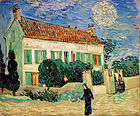
More or less acquainted with Impressionist and Neo-Impressionist techniques and theories, Van Gogh went to Arles to develop these new possibilities. But within a short time, older ideas on art and work reappeared: ideas such as series on related or contrasting subject matter, which would reflect on the purposes of art. As his work progressed, he painted a great many Self-portraits. Already in 1884 in Nuenen he had worked on a series that was to decorate the dining room of a friend in Eindhoven. Similarly in Arles, in spring 1888 he arranged his Flowering Orchards into triptychs, began a series of figures that found its end in The Roulin Family, and finally, when Gauguin had consented to work and live in Arles side-by-side with Van Gogh, he started to work on The Décoration for the Yellow House, which was by some accounts the most ambitious effort he ever undertook. Most of his later work is involved with elaborating on or revising its fundamental settings. In the spring of 1889, he painted another, smaller group of orchards. In an April letter to Theo, he said, "I have 6 studies of Spring, two of them large orchards. There is little time because these effects are so short-lived."
The art historian Albert Boime was the first to show that Van Gogh—even in seemingly fantastical compositions like Starry Night—based his work in reality. The White House at Night, shows a house at twilight with a prominent star surrounded by a yellow halo in the sky. Astronomers at Southwest Texas State University in San Marcos calculated that the star is Venus, which was bright in the evening sky in June 1890 when Van Gogh is believed to have painted the picture.
The paintings from the Saint-Rémy period are often characterized by swirls and spirals. The patterns of luminosity in these images have been shown to conform to Kolmogorov's statistical model of turbulence.
Self Portraits
Van Gogh created many self-portraits during his lifetime. He was a prolific self-portraitist, who painted himself thirty-seven times between 1886 and 1889. In all, the gaze of the painter is seldom directed at us; even when it is a fixed gaze, he seems to look elsewhere. The paintings vary in intensity and colour and some portray the artist with beard, some beardless, some with bandages; representing the episode in which he severed one of his ears. Self-portrait without beard, from the end of September 1889, is one of the most expensive paintings of all time, selling for $71.5 million in 1998 in New York. At the time, it was the third (or an inflation-adjusted fourth) most expensive painting ever sold. All of the self-portraits Van Gogh executed in Saint-Rémy show the artist's head from the left, i.e. with the side opposite his mutilated ear, showing only his good side. Many of Van Gogh's self portraits are depicting his face as it appeared in a mirror i.e. his left side in the image is in reality the right side of his face. During the final weeks of his life in Auvers-sur-Oise, although he was producing many paintings, Van Gogh did not paint any self-portraits.
Cypresses
One of the most popular and widely known series of Van Gogh's paintings are his Cypresses. During the Summer of 1889, at sister Wil's request, he made several smaller versions of Wheat Field with Cypresses. The works are characterised by swirls and densely painted impasto—and produced one of his best-known paintings – The Starry Night. Other works from the series have similar stylistic elements including Olive Trees with the Alpilles in the Background (1889) Cypresses (1889), Wheat Field with Cypresses (1889), (Van Gogh made several versions of this painting that year), Road with Cypress and Star (1890) and Starry Night Over the Rhone (1888). These have become synonymous with Van Gogh's work through their stylistic uniqueness. According to art historian Ronald Pickvance,
Road with Cypress and Star (1890), is compositionally as unreal and artificial as the Starry Night. Pickvance goes on to say the painting Road with Cypress and Star represents an exalted experience of reality, a conflation of North and South, what both Van Gogh and Gauguin referred to as an "abstraction". Referring to Olive Trees with the Alpilles in the Background, on or around 18 June 1889, in a letter to Theo, he wrote, "At last I have a landscape with olives and also a new study of a Starry Night."
Hoping to also have a gallery for his work, his major project at this time was a series of paintings including Still Life: Vase with Twelve Sunflowers (1888), and Starry Night Over the Rhone (1888) that all intended to form the décoration of the Yellow House.
Flowering Orchards
The series of Flowering Orchards, sometimes referred to as the Orchards in Blossom paintings, were among the first group of work that Van Gogh completed after his arrival in Arles, Provence in February 1888. The 14 paintings in this group are optimistic, joyous and visually expressive of the burgeoning Springtime. They are delicately sensitive, silent, quiet and unpopulated. About The Cherry Tree Vincent wrote to Theo on 21 April 1888 and said he had 10 orchards and: one big (painting) of a cherry tree, which I've spoiled. The following spring he painted another smaller group of orchards, including View of Arles, Flowering Orchards.
Van Gogh was taken by the landscape and vegetation of the South of France, and often visited the farm gardens near Arles. Because of the vivid light supplied by the Mediterranean climate his palette significantly brightened. From his arrival, he was interested in capturing the effect of the Seasons on the surrounding landscape and plant life.
Flowers
Van Gogh painted several versions of landscapes with flowers, as seen in View of Arles with Irises, and paintings of flowers, such as Irises, Sunflowers, lilacs, roses, oleanders and other flowers. Some of the paintings of flowers reflect his interests in the language of colour and also in Japanese ukiyo-e woodblock prints.
He completed two series of sunflowers: the first while he was in Paris in 1887, and the second during his stay in Arles the following year. The first series shows living flowers in the ground. In the second series, they are dying in vases. However, the 1888 paintings were created during a rare period of optimism for the artist. He intended them to decorate a bedroom where Paul Gauguin was supposed to stay in Arles that August, when the two would create the community of artists Van Gogh had long hoped for. The flowers are rendered with thick brushstrokes (impasto) and heavy layers of paint.
In an August 1888 letter to Theo, he wrote,
- "I am hard at it, painting with the enthusiasm of a Marseillais eating bouillabaisse, which won't surprise you when you know that what I'm at is the painting of some sunflowers. If I carry out this idea there will be a dozen panels. So the whole thing will be a symphony in blue and yellow. I am working at it every morning from sunrise on, for the flowers fade so quickly. I am now on the fourth picture of sunflowers. This fourth one is a bunch of 14 flowers ... it gives a singular effect."
The series is perhaps his best known and most widely reproduced. In recent years, there has been debate regarding the authenticity of one of the paintings, and it has been suggested that this version may have been the work of Émile Schuffenecker or of Paul Gauguin. Most experts, however, conclude that the work is genuine.
Wheat fields
Van Gogh made several painting excursions during visits to the landscape around Arles. He made a number of paintings featuring harvests, wheat fields and other rural landmarks of the area, including The Old Mill (1888); a good example of a picturesque structure bordering the wheat fields beyond. It was one of seven canvases sent to Pont-Aven on 4 October 1888 as exchange of work with Paul Gauguin, Emile Bernard, Charles Laval, and others. At various times in his life, Van Gogh painted the view from his window—at The Hague, Antwerp, Paris. These works culminated in The Wheat Field series, which depicted the view he could see from his adjoining cells in the asylum at Saint-Rémy.
Writing in July 1890, Van Gogh said that he had become absorbed "in the immense plain against the hills, boundless as the sea, delicate yellow". He had become captivated by the fields in May when the wheat was young and green. The weather worsened in July, and he wrote to Theo of "vast fields of wheat under troubled skies", adding that he did not "need to go out of my way to try and express sadness and extreme loneliness".
Working procedures
A self-taught artist with little training, Van Gogh was anything but academic in his painting and drawing techniques. Recent research has shown that works commonly known as "oil paintings" or "drawings" would better be described as "mixed-media". The Langlois Bridge at Arles shows highly elaborate under-drawing in pen and ink, while several works from Saint-Rémy and Auvers, hitherto considered to be drawings or watercolors, such as Vestibule of the Asylum, Saint-Remy (September 1889), turned out to be painted in diluted oil and with a brush.
Radiographical examination has shown that Van Gogh re-used older canvases more extensively than previously assumed—whether he really overpainted more than a third of his output, as presumed recently, must be verified by further investigations. In 2008, a team from Delft University of Technology and the University of Antwerp used advanced X-ray techniques to create a clear image of a woman's face previously painted, underneath the work Patch of Grass.
Legacy
Posthumous fame
Following his first exhibitions in the late 1880s, Van Gogh's fame grew steadily among colleagues, art critics, dealers and collectors. After his death, memorial exhibitions were mounted in Brussels, Paris, The Hague and Antwerp. In the early 20th century, there were retrospectives in Paris (1901 and 1905), and Amsterdam (1905), and important group exhibitions in Cologne (1912), New York City (1913) and Berlin (1914). These had a noticeable impact on later generations of artists. By the mid 20th century Van Gogh was seen as one of the greatest and most recognizable painters in history.
Influence
In his final letter to Theo, Vincent admitted that as he did not have any children, he viewed his paintings as his progeny. Reflecting on this, the historian Simon Schama concluded that he "did have a child of course, Expressionism, and many, many heirs." Schama mentioned a wide number of artists who have adapted elements of Van Gogh's style, including Willem de Kooning, Howard Hodgkin and Jackson Pollock. The French Fauves, including Henri Matisse, extended both his use of colour and freedom in applying it, as did German Expressionists in the Die Brücke group, as well as early modernism. Abstract Expressionism of the 1940s and 1950s is seen as in part inspired from Van Gogh's broad, gestural brush strokes. In the words of art critic Sue Hubbard: At the beginning of the twentieth century Van Gogh gave the Expressionists a new painterly language which enabled them to go beyond surface appearance and penetrate deeper essential truths. It is no coincidence that at this very moment Freud was also mining the depths of that essentially modern domain - the subconscious. This beautiful and intelligent exhibition places Van Gogh where he firmly belongs; as the trailblazer of modern art.
In 1957, Francis Bacon (1909–1992) based a series of paintings on reproductions of Van Gogh's The Painter on the Road to Tarascon, the original of which was destroyed during World War II. Bacon was inspired by not only an image he described as "haunting", but also Van Gogh himself, whom Bacon regarded as an alienated outsider, a position which resonated with Bacon. The Irish artist further identified with Van Gogh's theories of art and quoted lines written in a letter to Theo, "[R]eal painters do not paint things as they are...They paint them as they themselves feel them to be". An exhibition devoted to Vincent van Gogh's letters took place in the Van Gogh Museum in Amsterdam from October 2009 to January 2010 and then moved to the Royal Academy in London from late January to April.
